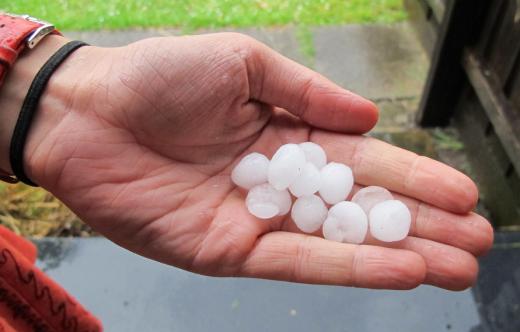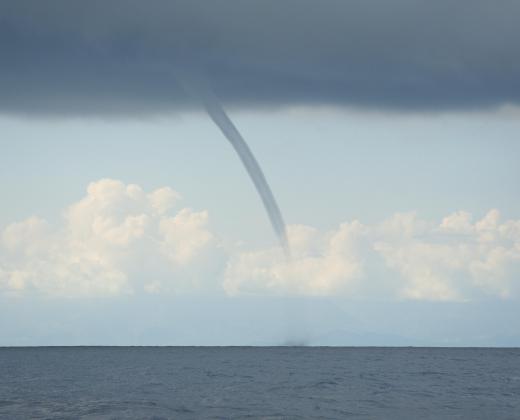What Is a Waterspout?
A waterspout is a cyclonic wind event resembling a tornado that occurs over open bodies of water, sometimes in small groups called a waterspout cluster or family. Unlike tornadoes over land that often become visible due to the dust and debris present within them, a waterspout is made up of swirling droplets of water. Many people assume that a waterspout is nothing more than a tornado over water. This is not entirely true, however, as some waterspouts can develop in relatively fair weather conditions unlike the stormy conditions that normally produce tornadoes. For this reason, waterspouts are categorized in one of two ways — tornadic or fair-weather.
A tornadic waterspout forms from the same type of conditions that produce tornadoes — usually very strong thunderstorms that can also produce very heavy rain, rough seas, high winds, and hail. Such a waterspout can form over water or over land. A tornado that forms over land and moves over water becomes a waterspout. It is no different than a normal tornado, except that it exists over water. It is even possible for a tornado to move over water, becoming a waterspout, then move on shore again as a tornado.

Sometimes a waterspout forms under relatively calm conditions and is called a fair weather waterspout. This term can be somewhat misleading, however, as this type of waterspout usually forms under a bank of low lying cumulus clouds. Calling these types of waterspouts fair weather waterspouts is a reference to the fact that they can form when no storms are present, and even though they usually occur under a cloud bank, it is possible for the weather to be very calm and even fairly sunny. It is rare for such a waterspout to make landfall and if it does, it generally dissipates very quickly.

The two types of waterspouts differ in several ways besides the conditions under which they form. Tornadic waterspouts can be dangerous and destructive and can have winds as strong as a tornado. Fair weather waterspouts, while potentially dangerous if they directly contact small watercraft, are generally much weaker than tornadic spouts, and tend to be more short-lived. Tornadic waterspouts start in the cloud layer and extend downwards but fair weather waterspouts start at water level and extend upwards. Fair weather waterspouts, which generally only form over fairly large bodies of water, occur more often than the tornadic variety, which can form anywhere a tornado is possible, although neither type of waterspout is particularly common.
AS FEATURED ON:
AS FEATURED ON:













Discussion Comments
I live near Lake Erie, and even regular tornadoes are rare here. I have seen one in my lifetime, and it spent part of its duration as a waterspout.
This was a pretty powerful tornado. It started out on land, and it destroyed several beach houses along the lake. Then, it moved onto the water, spinning several boats through the air and breaking them into bits.
Finally, it moved back onto land and took out a bait store and part of a wooded area before dissipating. I saw a lot of what happened from the narrow window in my basement.
I had a scary experience with a tornadic waterspout in the dark. I was staying at a beach condo with my church group, and a severe thunderstorm was pounding the area. We kept the news on to listen for tornado warnings.
While we sat there listening to the whipping wind, suddenly, the furniture on the balcony started to move. The chairs and the table scooted all the way across the concrete to the gate, and we all ran downstairs to the basement.
We could hear things slamming around, and one girl began to cry. We waited for the noise to pass, and then we went outside.
The waves had reached almost all the way to the condo floor. By the time we went out, they had receded a bit, but the water still was way too close to us.
We found out the next day that a tornadic waterspout had passed right by the condo, sucking towels and chairs off of balconies. We felt grateful to be alive.
@wavy58 - I have seen those from the beach in Florida. The local news even had footage of them from a helicopter, and from the way they talked, you would think they had video of a rainbow. They knew it was nothing to be afraid of, and it was quite beautiful.
I saw two at once while on the beach. They were really thin, and they reached from the sea to a group of clouds. Everyone started snapping photos, and I joined them.
No one seemed afraid. Apparently, they occur frequently during the summer months, so many of the vacationers were familiar with them.
I saw fair weather waterspouts two years in a row on my vacation to the Gulf Coast. Had my friend who was with me not told me what they were, I would have been running downstairs to the hotel basement for shelter.
The first time I saw one, the day was somewhat gray and cloudy, but no thunderstorms were present. I saw what looked like a slightly crooked gray finger extending from the ocean to some dark gray clouds.
It just felt wrong not to feel fear and hide while watching what looked exactly like a tornado, even though it was pretty far away. It appeared to be in line with the horizon. I think that if it had gotten close to shore, I would have taken cover regardless of the fact that it was just a fair weather waterspout.
Post your comments